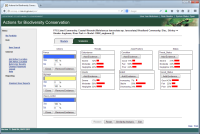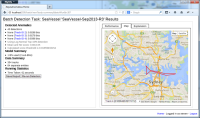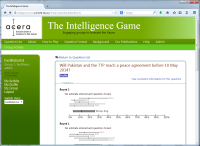|
|
Projects
We have experience with a wide variety
of Bayesian network applications.
-
- Modelling Threats to Species
 Victoria's Department of Sustainability and Environment (DSE) uses the Actions for Biodiversity Conservation system for recording information on threatened species across the state. We created a software component (known as ABC-BN) that fully integrates into this database, allowing species managers to explicitly model the impacts of threats on species and the effectiveness of management actions used to mitigate those threats. Victoria's Department of Sustainability and Environment (DSE) uses the Actions for Biodiversity Conservation system for recording information on threatened species across the state. We created a software component (known as ABC-BN) that fully integrates into this database, allowing species managers to explicitly model the impacts of threats on species and the effectiveness of management actions used to mitigate those threats.
ABC-BN provides a comprehensive set of tools for creating models of the factors affecting a species and exploring the predictions of those models. To keep things simple for managers, a template model structure is used that captures the fundamental elements important to every species' situation: namely, management actions, threats and population factors (such as species numbers or range). For any given species, managers are free to include in their model whatever actions, threats and population factors they believe to be important. Managers can then add links to indicate which actions affect which threats, and which threats impact upon which population factors. Parameterisation of the network is performed using natural language questions and prompts, with the ability to switch to tables and numbers for those more comfortable with BN concepts. After the models are reviewed and accepted, stakeholders can experiment with the created models by entering either certain or uncertain evidence (in the form of likelihoods) and produce reports indicating which actions and other factors are most likely to improve the status of threats and, ultimately, the status of the species.
-
Victorian Western Grasslands Reserves
 The Victorian Government is reserving 15,000 hectares of land to the west and north-west of Werribee as a way of protecting endangered grasslands and offsetting the ecological costs of urban growth to the north and west of Melbourne. The DSE wishes to provide Parks Victoria with an adaptive management process for these grasslands, which will involve modelling, predicting, monitoring and revising the model in repsonse to discrepancies that arise in the review. DSE has chosen Bayesian networks as the modelling technology, and we are building the initial models to be used in this process, as well as providing training. The Victorian Government is reserving 15,000 hectares of land to the west and north-west of Werribee as a way of protecting endangered grasslands and offsetting the ecological costs of urban growth to the north and west of Melbourne. The DSE wishes to provide Parks Victoria with an adaptive management process for these grasslands, which will involve modelling, predicting, monitoring and revising the model in repsonse to discrepancies that arise in the review. DSE has chosen Bayesian networks as the modelling technology, and we are building the initial models to be used in this process, as well as providing training.
-
- Biosecurity
 We are developing models for New Zealand's Scion research institute to minimise the risk of pests appearing in wood chips due for export. The aim is to sufficiently reduce the risk of attracting pests throughout the cutting, transportation and storage stages, such that costly and environmentally-unfriendly fumigation can be avoided prior to export. We are developing models for New Zealand's Scion research institute to minimise the risk of pests appearing in wood chips due for export. The aim is to sufficiently reduce the risk of attracting pests throughout the cutting, transportation and storage stages, such that costly and environmentally-unfriendly fumigation can be avoided prior to export.
-
- Anomaly Detection
 We are creating software for the Defence Science and Technology Organisation based on our machine learning software CaMML and earlier research work to detect anomalous behaviour in track data sets of various kinds (such as ships and cars). This project involves mining large time series data sets in order to produce causal models that yield an understanding of normal behaviour, against which anomalies can be assessed. The emphasis in the current project will be to allow users of the software to create and test models and to provide detection in an online environment. We are creating software for the Defence Science and Technology Organisation based on our machine learning software CaMML and earlier research work to detect anomalous behaviour in track data sets of various kinds (such as ships and cars). This project involves mining large time series data sets in order to produce causal models that yield an understanding of normal behaviour, against which anomalies can be assessed. The emphasis in the current project will be to allow users of the software to create and test models and to provide detection in an online environment.
-
-
Power Pole Maintenance
 Western Power manages over 700,000 power poles in Perth and surrounding areas, many of which are nearing the end of their service lives. Western Power has recently embarked on a project aimed at improving the safety of these poles, while minimising the maintenance cost. The company settled on Bayesian networks as the best approach to model the health of the wood poles, given their strong risk management capabilities. We are providing Western Power with modelling advice and performance-focused BN programming solutions to assist in managing the risk of power pole failure. Western Power manages over 700,000 power poles in Perth and surrounding areas, many of which are nearing the end of their service lives. Western Power has recently embarked on a project aimed at improving the safety of these poles, while minimising the maintenance cost. The company settled on Bayesian networks as the best approach to model the health of the wood poles, given their strong risk management capabilities. We are providing Western Power with modelling advice and performance-focused BN programming solutions to assist in managing the risk of power pole failure.
-
Aggregating Expert Forecasts
 The US government organisation IARPA established the ACE (Aggregative Contingent Estimation) program in order to develop and improve methods for eliciting conditional predictions from experts and also for aggregating those predictions into a single prediction. One of the teams participating in that program is a group called DAGGRE, based at George Mason University. Together with ACERA, we are assisting DAGGRE with the development of their combinatorial prediction market software, now based on an underlying BN back-end, along with their conditional and unconditional elicitation processes. We additionally created information gathering and elicitation software for ACERA's own elicitation and aggregated prediction experiments. The US government organisation IARPA established the ACE (Aggregative Contingent Estimation) program in order to develop and improve methods for eliciting conditional predictions from experts and also for aggregating those predictions into a single prediction. One of the teams participating in that program is a group called DAGGRE, based at George Mason University. Together with ACERA, we are assisting DAGGRE with the development of their combinatorial prediction market software, now based on an underlying BN back-end, along with their conditional and unconditional elicitation processes. We additionally created information gathering and elicitation software for ACERA's own elicitation and aggregated prediction experiments.
References References are available upon request.
|



